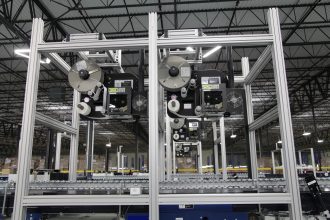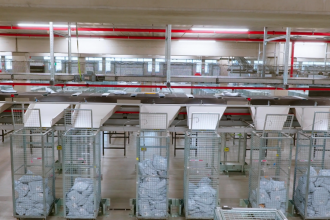Measuring Efficiency in SLAM Operations

Regular monitoring of your last 100 feet can help keep errors down.
If you are considering automating your warehouse’s last 100 feet—the area where scanning, labeling, applying and manifesting takes place—odds are you are trying to solve one of several problems. The most common reason is the labor shortage, and you have too few hands to help you complete your SLAM tasks efficiently without help. You also likely want to improve your accuracy rates with shipping, something SLAM can greatly improve. Finally, you might be considering SLAM to increase your efficiency rate.
Whatever the case may be, SLAM will play an integral part in your peak season shipping. The automation will keep your packages moving and get them to the right places at a much higher rate than if you didn’t employ the equipment. Still, even with automation, things can go wrong in the last 100 feet and it pays to monitor the area carefully to learn from any mistakes made.
You can’t learn from mistakes that you aren’t monitoring throughout your SLAM processes and equipment. This matters all year round, but especially during your busy season. However, if you haven’t implemented monitoring strategies prior to peak season, you’ll miss out on identifying any issues along the way.
There are many essential metrics you should be tracking with your SLAM operations. All can help you pinpoint any issues in your processes or with your equipment. In the end, they can mean the difference between a happy and an unhappy customer. The dollar value of a happy customer in the moment of shipping and receiving, is the difference between your costs and your sales price. If all went well and there are no errors, that can increase exponentially, especially during peak season. If your customer is happy, they will stay a customer and they may refer you to new business, too.
Key measurements in the SLAM area should include response time, read rates, verification rates, mechanical efficiency, software latency, and shipping errors, among others. Back to the happy customer—the opposite is an unhappy customer due to a shipping error. If you aren’t measuring the above metrics, then you may never know what went wrong in shipping. Then you have no chance to course correct and try to keep your customer.
Redundancy in SLAM operations is a good avenue for verifying and measuring. By scanning downstream at the point of sortation, you get a back-up check point. This helps prevent errors in the first place but can also serve as a check after the fact if an error occurred.
Monitoring key metrics in SLAM should be an ongoing operation, not something you do on January 1 after peak season has occurred. Whether daily or weekly, measuring your rates will allow you to gather the necessary data to analyze after the fact should something go wrong.
Finally, do not depend wholly on your equipment to get you through peak season—training matters, too, and if your staff makes errors, you can still have mistakes. You’re counting on your equipment to operate correctly and barring breakdowns, it will. But make sure your staff can do their part, too.
The MHI SLAM Industry Group is conducting a survey to better understand the challenges and opportunities facing the ecommerce fulfillment operations. As a practitioner in this field, your insight and experiences are of utmost importance to us. We would be grateful if you could spare a few minutes to share your thoughts and opinions through this survey. Your participation will contribute to shaping the future of the industry.
To learn more about MHI’s SLAM industry group: www.mhi.org/slam
More information about Scanning, Labeling, Applying, Manifesting:
Podcast: Elevating Order Fulfillment: VRCs & SLAM Efficiency in the Modern Warehouse
How SLAM Saves on Shipping Costs
Prevent Chargebacks Via SLAM Equipment
Why SLAM Should Include Dimensioning Equipment
Why A Vertical Reciprocating Conveyor Can Play A Critical Role …



